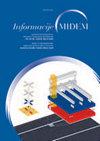A 0.35μm Low-Noise Stable Charge Sensitive Amplifier for Silicon Detectors Applications
IF 0.8
4区 工程技术
Q4 ENGINEERING, ELECTRICAL & ELECTRONIC
Informacije Midem-Journal of Microelectronics Electronic Components and Materials
Pub Date : 2020-04-20
DOI:10.33180/infmidem2020.101
引用次数: 5
Abstract
The Charge Sensitive Amplifier (CSA) is the key module of the front-end electronics of various types of Silicon detectors and most radiation detection systems. High gain, stability, and low input noise are the major concerns of a typical CSA circuit in order to achieve amplified susceptible input charge (current) for further processing. To design such a low-noise, stable, and low power dissipation solution, a CSA is required to be realized a complementary metal-oxide-semiconductor (CMOS) technology with a compact design. This research reports a low-noise highly stabile CSA design considerations for Silicon detectors applications, which has been designed and validated in TSMC 0.35um CMOS process. In a typical CSA design, the detector capacitance and the input transistor’s width are the most dominating parameters for achieving low noise performance. Therefore, the Equivalent Noise Charge (ENC) with respect to those parameters has been optimized, for a set of detector capacitance from 0.2pF – 2pF. However, the parallel noise of the feedback was removed by adopting a voltage-controlled NMOS resistor, which in turn helped to achieve high stability of the circuit. The simulation results provided a baseline gain of 9.92mV/fC and show that ENC was found to be 42.5e – with 3.72 e – /pF noise slope. The Corner frequency exhibited by the CSA is 1.023GHz and the output magnitude was controlled at -56.8dB; it dissipates 0.23mW from with a single voltage supply of 3.3V with an active die area of 0.0049 mm 2 .用于硅探测器的0.35μm低噪声稳定电荷敏感放大器
电荷敏感放大器(CSA)是各类硅探测器和大多数辐射探测系统前端电子器件的关键模块。高增益、稳定性和低输入噪声是典型CSA电路的主要关注点,以实现放大的敏感输入电荷(电流),以便进一步处理。为了设计这样一个低噪声、稳定和低功耗的解决方案,CSA需要实现紧凑设计的互补金属氧化物半导体(CMOS)技术。本研究报告了一种低噪声高稳定的CSA设计考虑,用于硅探测器的应用,该CSA已在台积电0.35um CMOS工艺中设计和验证。在典型的CSA设计中,检测器电容和输入晶体管的宽度是实现低噪声性能的最主要参数。因此,等效噪声电荷(ENC)相对于这些参数进行了优化,一组检测器电容从0.2pF - 2pF。然而,通过采用压控NMOS电阻消除了反馈的并行噪声,从而有助于实现电路的高稳定性。仿真结果提供了9.92mV/fC的基线增益,并且发现ENC为42.5e -,噪声斜率为3.72 e - /pF。CSA显示的拐角频率为1.023GHz,输出幅度控制在-56.8dB;它从3.3V的单电压电源中耗散0.23mW,有效模面积为0.0049 mm 2。
本文章由计算机程序翻译,如有差异,请以英文原文为准。
求助全文
约1分钟内获得全文
求助全文
来源期刊
CiteScore
1.80
自引率
0.00%
发文量
10
审稿时长
>12 weeks
期刊介绍:
Informacije MIDEM publishes original research papers in the fields of microelectronics, electronic components and materials. Review papers are published upon invitation only. Scientific novelty and potential interest for a wider spectrum of readers is desired. Authors are encouraged to provide as much detail as possible for others to be able to replicate their results. Therefore, there is no page limit, provided that the text is concise and comprehensive, and any data that does not fit within a classical manuscript can be added as supplementary material.
Topics of interest include:
Microelectronics,
Semiconductor devices,
Nanotechnology,
Electronic circuits and devices,
Electronic sensors and actuators,
Microelectromechanical systems (MEMS),
Medical electronics,
Bioelectronics,
Power electronics,
Embedded system electronics,
System control electronics,
Signal processing,
Microwave and millimetre-wave techniques,
Wireless and optical communications,
Antenna technology,
Optoelectronics,
Photovoltaics,
Ceramic materials for electronic devices,
Thick and thin film materials for electronic devices.

 求助内容:
求助内容: 应助结果提醒方式:
应助结果提醒方式:


